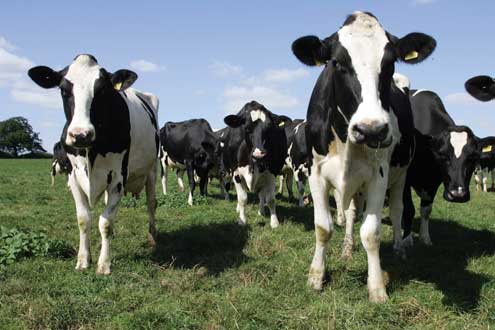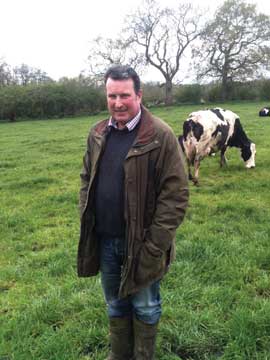‘Know where you are in relation to your targets’

 There is no doubt dairy farming is going through a difficult patch, with more and more producers leaving the industry each day. But by taking steps to streamline management processes, farmers can improve their bottom line.
There is no doubt dairy farming is going through a difficult patch, with more and more producers leaving the industry each day. But by taking steps to streamline management processes, farmers can improve their bottom line.
One business doing just that is Grasslands, a specialist contract farm management company. On one of their farms, manager Phil Asbury, who keeps a spring-block calving herd of 210 Kiwi Friesian and crossbred Jersey cows at Clive Hall Farm in Cheshire, is paving the way for their other units to improve efficiencies at farm level.
Clive Hall Farm is currently in year three of a dairy lean management programme – initially funded by Reaseheath College and DairyCo – and as a result of streamlining management practices, yields and margin a litre have increased.
“We started with this system two years ago and it has really helped us to look at the costs involved in the farm, review what we do and try to improve pretty much everything we do on the farm,” explains Mr Asbury, who is a Livestock North West monitor farmer.
“By recording measures of input use and production, we have been able to identify waste and reduce it. We are making better use of the grass we are growing and reducing the amount of corn we feed the cows.”
Before entering into the contract farming arrangement with Grasslands, Mr Asbury was farming 160-170 Holstein Friesian cows, averaging 7,500 litres from 1.5-2t of concentrates, on a predominantly autumn-calving system.
“I wasn’t happy with what I was doing and where I was at that time of my life. I had no family time and I wasn’t making any money,” says Mr Asbury.
“We have since put in concrete sleepers and the main focus is better use of grass through paddock grazing. We aim to grow 14t DM/ha and use 83-85% of that – the other 15% is waste.”
Lean management
The lean management programme at Clive Hall started in June 2010 with the aim of adding maximum value to inputs and minimising waste.
Run in conjunction with independent consultant Kay Carson from Streamline Farm Management, the system aims to map each management process on the farm and set achievable key performance indicators (KPIs) to boost efficiency.
“What’s different in lean management is that we do this right across the enterprise; if you want to make a profit, you need to get all the systems right on your farm,” explains Dr Carson.
| Tips |
|---|
|
At farm level, Mr Asbury collates information and data on everything that happens on the farm – tank litres, time taken to milk, number of cows calving – in an electronic diary developed by Dr Carson, which takes 15-30 minutes each day.
“For the first 12 months we were collecting the data, it didn’t mean an awful lot. But now we have a tool to use to look at what we have done and review it – we’re always trying to improve what we’re doing by reviewing what’s happened in the past,” says Geoff Booth, operations director at Grasslands, who works closely with Mr Asbury to improve the unit.
“For example, if we have three to four weeks of dry weather, we can decide how to use fertiliser, and if we have had 5-6mm of rain the week before, we will put fertiliser on,” says Mr Asbury.
He describes the programme as a “wake-up call” and a “real kick up the backside”.
And since paying more attention to efficiencies, average herd yield on the 62ha unit has increased from 4,800 to 5,100 litres, and the margin has increased by 2p/litre.
When it comes to money saving, previously good decisions made on how to graze and use grass have improved as a result of having access to better information collected through the electronic diary, he adds.
“The programme enables me to make a decision and do a ‘what if’ scenario, so that, for example, when we use the contractor, we can make better use of his time. And we have grown and eaten a tonne more grass for every hectare than the year before – we grew 10-10.5t/ha in 2010 and last year we grew 12.7 and used 11t/ha.”
Andrew Fletcher, managing director, says reviewing what you do on farm is important because otherwise you don’t know whether you are going forwards or backwards. “You need to know where you are in relation to your targets,” he adds.
“I’m still improving and I still have a way to go yet, but the information is all about understanding and reviewing it and being able to fill in the diary; each time I have something to relate back to now.”
| Lean management explained |
|---|
What is lean management? A common management tool kit in manufacturing industry, lean management provides the means of managing processes right through from planning to final outcome. The two main objectives are to eliminate waste and maximise value. Why is it relevant to dairy farmers? Lean management provides a structure of on-farm data collection and review focused on increasing production efficiency. Although many dairy farms collect a lot of data, it is not always reviewed regularly, or systematically, so its value for decision-making is lost to the business. How does the programme work on farm? The programme allows producers to assess how effectively each production process on farm is managed, from grass production to fertility. With this information, they can identify short-term KPIs to meet monthly and annual targets, including daily grass residuals needed to deliver total DM grass production per ha in the year. In addition, it creates a regular data collection system that allows vital regular review of management procedures and decisions on action moving forward. |
Interested in dairy farming? Why not subscribe to receive a free online digital edition of Dairy Update?
